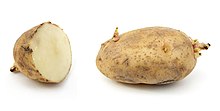
French fries, chips, finger chips, french-fried potatoes, or simply fries, are batonnet or allumette-cut deep-fried potatoes of disputed origin from Belgium or France. They are prepared by cutting potatoes into even strips, drying them, and frying them, usually in a deep fryer. Pre-cut, blanched, and frozen russet potatoes are widely used, and sometimes baked in a regular or convection oven; air fryers are small convection ovens marketed for frying potatoes.

The potato is a starchy food, a tuber of the plant Solanum tuberosum and is a root vegetable native to the Americas. The plant is a perennial in the nightshade family Solanaceae.

The sweet potato or sweetpotato is a dicotyledonous plant that belongs to the bindweed or morning glory family, Convolvulaceae. Its large, starchy, sweet-tasting tuberous roots are used as a root vegetable. The young shoots and leaves are sometimes eaten as greens. Cultivars of the sweet potato have been bred to bear tubers with flesh and skin of various colors. Sweet potato is only distantly related to the common potato, both being in the order Solanales. Although darker sweet potatoes are often referred to as "yams" in parts of North America, the species is not a true yam, which are monocots in the order Dioscoreales.

Pierogi are filled dumplings made by wrapping unleavened dough around a savory or sweet filling and cooking in boiling water.

A baked potato, known in some parts of the United Kingdom as a jacket potato, is a preparation of potato. It may be served with fillings, toppings or condiments such as butter, cheese, sour cream, gravy, baked beans, and even ground meat or corned beef.

The J. R. Simplot Company is an agribusiness company headquartered in Boise, Idaho.

Russet Burbank is a potato cultivar with dark brown skin and few eyes that is the most widely grown potato in North America. A russet type, its flesh is white, dry, and mealy, and it is good for baking, mashing, and french fries (chips). It is a common and popular potato.
The Red Pontiac is a red-skinned early main crop potato variety originally bred in the United States, and is sold in the United States, Canada, Australia, Algeria, the Philippines, Venezuela and Uruguay. It arose as a color mutant of the original Pontiac variety in Florida by a J.W. Weston in 1945. It was registered by the USDA in 1983. The original Pontiac itself was a hybrid of varieties "Triumph" and "Katahdin" and released in the US in 1938 and Australia in 1940.

Luther Burbank was an American botanist, horticulturist and pioneer in agricultural science. He developed more than 800 strains and varieties of plants over his 55-year career. Burbank's varied creations included fruits, flowers, grains, grasses, and vegetables. He developed a spineless cactus and the plumcot.

A great variety of cassava-based dishes are consumed in the regions where cassava is cultivated, and the ingredient is included many national or ethnic specialities.
Alturas is a russet potato variety released in 2002 by the USDA-ARS and the Agricultural Experiment Stations of Idaho, Oregon, and Washington and it is under plant variety protection. It is a processing potato that has cold-sweetening resistance, so it can be processed directly out of storage into French fries and other frozen potato products.

Bintje is a middle-early ripening potato variety bred in the Netherlands by the Frisian schoolmaster K.L. de Vries in 1904 from and marketed for the first time in 1910. The name of the potato, a diminutive of Benedict, was borrowed from one of his former students.
Umatilla Russet is a moderately late maturing variety of potato especially suitable for frozen french fries processing. It was jointly released by the Agricultural Experiment Station of Oregon, Idaho, and Washington and the U.S. Department of Agriculture in 1998. 'Umatilla Russet' has been equal to or better than Russet Burbank in fry color in Oregon and regional trials. The potato was named by the state of Oregon after the Umatilla tribe, from which the city of Umatilla also takes its name.
The Ranger Russet is a late-maturing potato that is used for baking and processing into fries. It was originally bred by Joseph J. Pavek of the USDA in Aberdeen, Idaho, and released jointly by the USDA and the agricultural stations of Idaho, Washington, Oregon and Colorado in 1991. Ranger Russet is not under plant variety protection. It yields medium to high numbers of tubers with a short dormancy period.

Northern Irish cuisine encompasses the cooking styles, traditions and recipes associated with Northern Ireland. It has distinctive attributes of its own, but has also drawn heavily from Irish and British cuisines.

Prince Edward Island Potatoes refers to the brand and geographic identifier for potatoes grown and packaged in Prince Edward Island, a Maritime Province on the Atlantic coast of Canada.

A genetically modified potato is a potato that has had its genes modified, using genetic engineering. Goals of modification include introducing pest resistance, tweaking the amounts of certain chemicals produced by the plant, and to prevent browning or bruising of the tubers. Varieties modified to produce large amounts of starches may be approved for industrial use only, not for food.
Innovator is potato variety that is oblong in shape with a smooth skin. It is a popular potato variety in Europe and is gaining popularity in North America as a frying and baking potato. The skin of the potato variety is russeted, similar to that of a Russet Burbank potato. Innovator also has shallow eyes with a cream coloured flesh.

Cooking the potato, a tuber that has been consumed for more than 8,000 years, only really developed after the 16th century, and took nearly three centuries to become established in certain regions. In the 20th century, this type of cooking was practiced on all continents, as the potato, a source of carbohydrates, proteins and vitamin C, was easy to grow and became one of the staple foods of mankind; the method of preparation, however, can modify its nutritional value.















